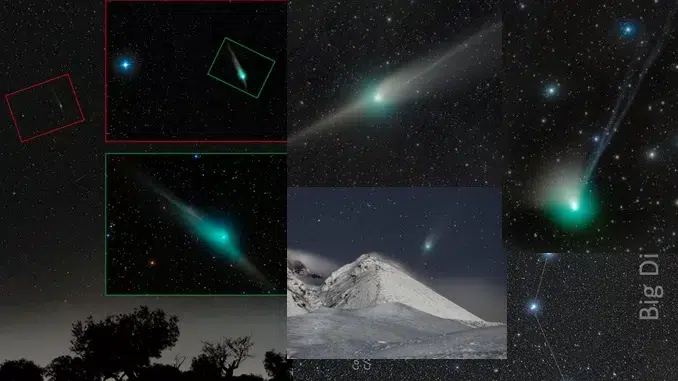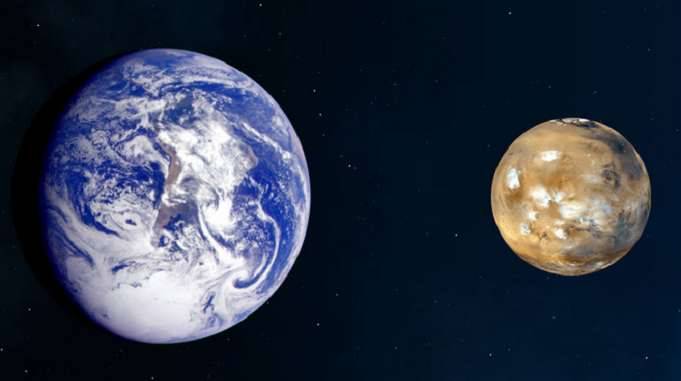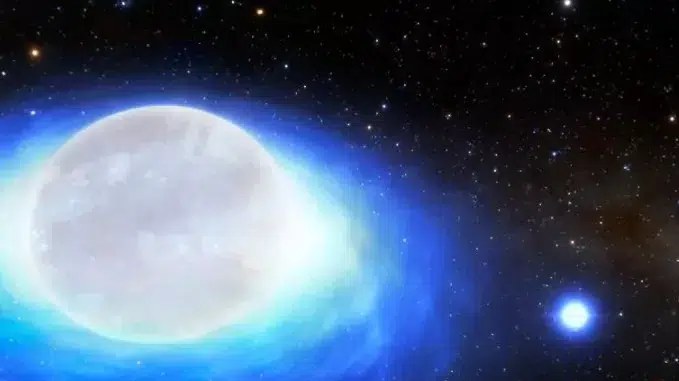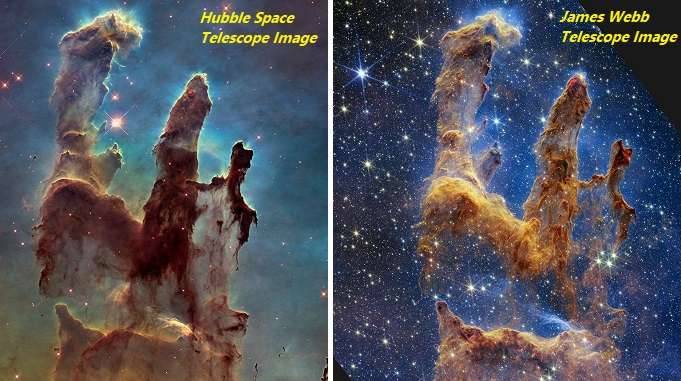
What are Comets?
Comets are small astronomical objects that revolve around the Sun. They are frozen remnants of the formation of the Solar System and are mainly made of ice, rock, and dust. They are the size of a small town when frozen.
In other words, comets are cosmic snowballs of rock, dust, and frozen gases that orbit around the Sun. The width of them varies from a few miles to tens of miles.
When a comet’s orbit brings it close to the Sun, it heats up and spews gases and dust into a giant glowing head, that is larger than most planets. The dust and gases combine to form a tail that extends millions of kilometers away from the Sun.
Where do Comets come from?
Comets are believed to come from 2 places in the Solar System:
1. Oort Cloud, and
2. Kuiper Belt.
In the Kuiper Belt and even more distant Oort Cloud, there are probably billions of comets orbiting our Sun. There are currently 3,855 comets that are known.
1. Oort Cloud –
The Oort Cloud is a region located nearly a light-year away from the Sun. The comets in the Oort Cloud are known as long-period comets, because Oort Cloud comets have extremely long orbital periods, spanning several million years.
2. Kuiper Belt –
The Kuiper Belt is a region located in space beyond the planet Neptune’s orbit. The comets in the Kuiper Belt are known as short-period comets, because Kuiper Belt comets have short orbital periods, usually around 200 years.
What is a Light Year – A light year (light-year or lightyear) is a unit of distance. According to International Astronomical Union, “a light year is the distance traveled by light in a vacuum during a Julian year”. A light year is approximately equal to 6 trillion miles (10 trillion kilometers.
They have a Coma –
When the comets come close to the Sun, most comets develop a tail, known as a coma, which is one of their distinguishing characteristics.
In astronomy, a coma is a diffuse cloud of gas and dust surrounding the nucleus of a comet.
Away from the Sun, comets are frozen, mysterious celestial objects that are hard to detect. But as a comet gets nearer to the Sun, its ice and dust are vaporized by the Sun’s heat and radiation. These evaporated gases collect dust and stream from the comet’s center, just like a tail. This tail may extend for thousands of miles long.
What are comets made of? What are the different parts of a comet?
Comets are composed of a mixture of dust, rock, water ice, and frozen gases such as carbon dioxide, methane, and ammonia. The typical structure of Comets is composed of three distinct parts: the nucleus, coma, and tail.
1. Nucleus – The nucleus of a comet is the solid, central part of the comet and is made up of ice, gas, dust, and rocks.
2. Coma – The coma is the fuzzy part of a comet that forms when the comet is heated by the Sun, releasing gas and dust. That is, the coma is an envelope of gas and dust that surrounds the nucleus and can measure up to a million kilometers across.
3. Tail – Comet tails are expansions of the coma, and point away from the Sun regardless of the direction in which the comet is traveling. The tail forms as gas and dust is pushed away from the comet by the pressure of solar radiation and the solar wind. The tail is the last part of a comet and is made up of three distinct parts: the plasma or ion tail, the dust tail, and the envelope tail.
Comets usually have two tails: Dust tail, and Gas tail; that point in different directions.
(i) Dust Tail – One tail is caused by the dust in the comet. This tail, which is also called the dust tail, is usually broad and curved. The dust tail is composed of tiny particles of ice and dust that are pushed away from the coma by the solar wind. The dust tail is left behind in the comet’s orbit.
(ii) Gas or Plasma or Ion Tail – The comet’s secondary tail, often called the plasma or ion tail is made by the gases in the comet. This tail points along the streamlines of the solar wind. It tends to point directly away from the Sun and is thin and straight. The plasma or ion tail is the most visible and is composed of charged particles that are pushed away from the sun by solar radiation. The ion tail follows the magnetic field lines rather than an orbital trajectory.
Envelope tail – The envelope tail is the outermost layer and is composed of gas and dust that is slowly pushed away from the sun by solar radiation. The envelope tail of a comet is a luminous, diffuse gaseous cloud that is typically seen for a short time when the comet is close to the Sun.
It is made of material that has been ejected from the nucleus of the comet. The envelope tail often follows the comet’s dust tail and can be seen before the dust tail is illuminated by the Sun. The envelope tail is formed due to the increased solar radiation experienced by the comet as it approaches the Sun, which causes the nucleus to heat up and eject material. The material is then pushed away from the Sun by the solar wind, forming the envelope tail.
Difficult to see –
Some comets are bright enough to be seen with the naked eye, but the majority of comets that pass close to the Sun are difficult to observe from Earth without specialized equipment. A comet’s brightness is caused by sunlight reflecting and refracting off dust in its tail.
What is Green Comet –
Green Comet is an astronomical phenomenon that has been gaining attention in the past few years. It is caused by a reaction between the sun’s outgassing particles and diatomic carbon (C2), which creates a bright verdant glow around the comet.
In such astronomical phenomena, known as a “Green Comet”, a comet appears green color due to the presence of certain elements in its composition like carbon dioxide and cyanogen. When these elements become ionized they release light of different colors as they travel through the Solar System, resulting in a green comet.
It is thought to be the result of a combination of several factors, including its orbital length, distance from Earth, and the angle at which it passes, etc.
Green comets are rare, but they have been observed throughout history, most notably in China during the Song Dynasty. The Great Comet of 1811, the Great Comet of 1556, and the Great Comet of 1882 are some of the more well-known green comets.
The green comet “C/2022 E3 (ZTF)” was first discovered in March 2022 at the Zwicky Transient Facility in California, and it is believed to have come from the Oort cloud – a collection of icy bodies that are thought to exist in the remotest part of the solar system. This green comet is unique because it is the first to be recognized by the International Astronomical Union (IAU) in 50,000 years.
To witness this spectacular sight, the best time to view the comet is after midnight when it is at its highest point in the sky. If one is lucky, one might even be able to see one of its vast tails.
Comet C/2022 E3 (ZTF) and Mars on Feb 13, 2023
C/2022 E3 (ZTF), nicknamed the Green Comet because of its bright green coma, did, however, pass almost in front of the much-more-distant planet a few days ago, very near in time to when the featured picture was taken. Don’t worry; Comet ZTF won’t strike Mars.

The comet’s light blue ion tail trails towards the top of the image, while its white dust tail can be seen to the right of the comet’s green coma. Orange Mars is well in front of the numerous background stars as well as the dark nebula Barnard 22 to its lower right.
Mars will remain to be visible in the evening sky for the next few months, but Comet ZTF has already started to lose brightness because it returns to the outer Solar System.
Read Also –
The ‘Green Comet’ Everyone is Talking About: How to See Green Comet?
Bright Green Comet passing by Earth in 2023 may be seen by the naked eye
Copyrighted Material © 2019 - 2024 Prinsli.com - All rights reserved
All content on this website is copyrighted. It is prohibited to copy, publish or distribute the content and images of this website through any website, book, newspaper, software, videos, YouTube Channel or any other medium without written permission. You are not authorized to alter, obscure or remove any proprietary information, copyright or logo from this Website in any way. If any of these rules are violated, it will be strongly protested and legal action will be taken.





Be the first to comment